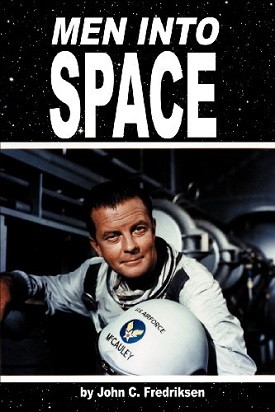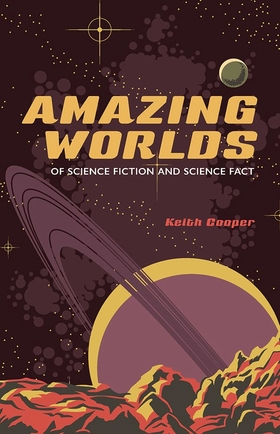Centauri Dreams
Imagining and Planning Interstellar Exploration
The Long Result
I conceived an early love for Tennyson, but it wasn’t until a bit later in life that I ran into his “Locksley Hall,” which contains lines many science fiction fans are familiar with:
Many a night I saw the Pleiads, rising thro’ the mellow shade,
Glitter like a swarm of fire-flies tangled in a silver braid.
Here about the beach I wander’d, nourishing a youth sublime
With the fairy tales of science, and the long result of Time;
When the centuries behind me like a fruitful land reposed;
When I clung to all the present for the promise that it closed:
When I dipt into the future far as human eye could see;
Saw the Vision of the world and all the wonder that would be.—
and so on. The poem is the lament of a soldier returning to the places of his boyhood and eventually turning his thoughts, and his resolve, on the future. When I read the line ‘the long result of time,’ I realized that it was here that I found resonance with the poet. The idea of a remote futurity and the need to build its foundations now was a powerful motivator.
Building Structures That Last
A sense of that futurity pervaded our recent sessions at the Tennessee Valley Interstellar Workshop in Huntsville. Several speakers alluded to instances in human history where people looked well beyond their own generation, a natural thought for a conference discussing technologies that might take decades if not centuries to achieve. We talked about a solar power project that might take 35 years, or perhaps 50 (much more about this in coming days).

The theme became explicit when educator and blogger Mike Mongo talked about getting interstellar issues across to the public, referring to vast projects like the pyramids and the great cathedrals of Europe. Cathedrals are a fascinating study in their own right, and it’s worth pausing on them as we ponder long-term notions. Although they’re often considered classic instances of people building for a remote future, some cathedrals were built surprisingly quickly. Anyone who has stood in awe at the magnificent lines of Chartres southwest of Paris is surprised to learn that it came together in less than 60 years (the main structure in a scant 26), though keep in mind that this was partly a reconstruction of an earlier structure that dated back to 1145.
Image: The great cathedral at Chartres.
With unstinting public support, such things could happen even with the engineering of the day, creating what historians now view as the high point of French Gothic art. Each cathedral, of course, tells its own tale. Salisbury Cathedral was completed except for its spire in 45 years. Other cathedrals took longer. Notre Dame in Paris was the work of a century, as was Lincoln Cathedral, while the record for cathedral construction surely belongs to Cologne, where the foundation stone was laid in 1248. By the time of the Reformation 300 years later, the roof was still unfinished, and later turmoil pushed the completion of the cathedral all the way into the 19th Century, with many stops and starts along the way.
Remember, too, that the cathedral builders lived at a time when the average lifespan was in the 30s. The 15-year old boy who started working on the foundation of a cathedral might have hoped to see its consecration but he surely knew the odds didn’t favor it. Humans are remarkably good at this kind of thing, even if the frenetic pace and short-term focus of our times makes us forget it. Robert Kennedy pointed out to me at the conference that the Dutch dike system has been maintained for over 500 years, and can actually be traced back as far as the 9th Century. The idea of technology-building across generations is hardly something new to our civilization.
The ‘long result’ context is an interesting one in which to place our interstellar thinking. Naturally we’d like to make things happen faster than the 4000-year plus journeys I talked about on Friday with worldships, though my guess is that as the species becomes truly spacefaring and begins to differentiate, we’ll see colonies aboard O’Neill-class cylinders holding thousands, many of the colonists being people who will spend less and less time on a planetary surface. At some point, it would be entirely natural to see one of these groups decide to head into the interstellar deep. They would be, after all, taking their world with them, a world that was already home.
Evolutionary Change in Space
Gerald Driggers is a retired engineer and current science fiction author who worked with Gerald O’Neill in the 1970s. I see him as worldship material because he has chosen for the last seventeen years to live on a boat, saying “It was the closest thing I could get to a space ship.” Driggers believes we can begin our interstellar work by getting humans to Mars, where they will be faced with many of the challenges that will attend much longer-term missions. We must, after all, build a system-wide infrastructure, mastering the complexities of power generation and resource extraction on entirely new scales, before we can truly hope to go interstellar.
And what happens to humans as they begin working in extreme environments? Evolution doesn’t stop when we leave the planet, as Freeman Dyson is so fond of pointing out. These are changes that should be beneficial, says Driggers. “Evolutionary steps toward becoming interstellar voyagers reduce the chances for human failures on these journeys. We’re going to change, and we will continue to change as we look toward longer voyages. The first humans to arrive around another star system probably won’t be like anybody in the audience today.” Responding to evolutionary change, Martians may make the best designers and builders of interstellar craft.
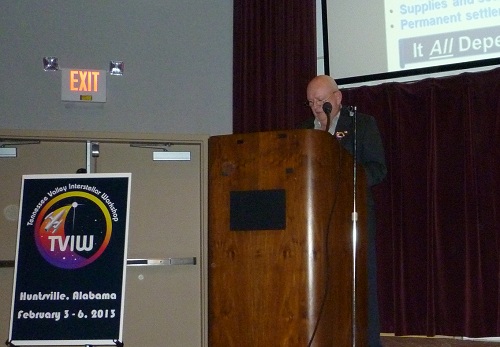
Image: Gerald Driggers discussing a near-term infrastructure that will one day support interstellar missions.
Get it right on Mars, in other words, and we get it right elsewhere and learn the basics of infrastructure building all the way to the Kuiper Belt, with active lunar settlements and plentiful activity among the asteroids. Along the way we adapt, we change. Driggers’ worst-case scenario has Martian settlements delayed until the mid-22nd Century, but he is hopeful that the date can be moved up and the infrastructure begun.
All of which brings me back to something Mike Mongo talked about. We are not going to the stars ourselves, but we can inspire and train people who will solve many of the technical problems going forward, just as they train the next generation. One of these generations will one day train the crew of the first human interstellar mission, or if we settle on robotics, the controllers who will manage our first probes. Placing ourselves in the context of the long result acknowledges our obligation to future generations as we begin putting foundation stones in place.

Interstellar Flight: Adapting Humans for Space
It’s surprising but gratifying that we can now talk about the ‘interstellar community.’ Just a few years back, there were many scientists and engineers studying the problems of starflight in their spare time, but when they met, it was at conferences dedicated to other subjects. The fact that the momentum has begun to grow is made clear by the explicitly interstellar conferences of recent memory, from the two 100 Year Starship symposia to the second Tennessee Valley Interstellar Workshop. Icarus Interstellar is mounting a conference this August in Dallas, and the Institute for Interstellar Studies plans its own gathering this fall in London.

Of course the Internet is a big part of the picture — Bob Forward and his colleagues could use the telephone and the postal service to keep in touch, but the energizing power of instant document exchange and online discussion was in the future. All this was apparent in Huntsville for the Tennessee Valley event, from which I have just returned. There was an active Twitter channel open and video streaming of the talks, and although I had little time to answer them, I was getting emails from many interested parties who couldn’t attend. Getting copies of papers and presentations after the conference closed can be managed in hours on the Net.
Starflight challenges not only everything we know about propulsion but also our understanding of human nature. If we are seriously considering human travel to such distant destinations, we are looking at decades of travel time at a bare minimum, or the possibility of a generation ship in which people live their lives entirely aboard the craft, which could take hundreds or even thousands of years to reach its destination. Astronaut Jan Davis, who gave the keynote in Huntsville, talked about the various problems of even short duration spaceflight based on her own experience of multiple Shuttle missions.
Image: Rockets dominate the Huntsville skyline in this shot I took from the Calhoun Community College on the final night of the workshop.
Some of these issues are well identified, including the lack of privacy and the loss of muscle and bone mass due to prolonged weightlessness. The privacy issue balances oddly with a sense of isolation, Davis said, as you are cut off from all aspects of your normal life. “You hear a lot of voices, but they’re not the voices you take for granted every day. I missed my dog. I missed sounds like wind, waves hitting the shore. You’re busy, but you’re also isolated.” As medical officer on her two flights, Davis trained on emergency procedures in case a crewmember became incapacitated. The main issue was to stabilize a patient long enough that he or she could be swiftly returned to Earth.
The conclusion from all this is that humans are adapted for Earth, not space, yet they have key advantages over robotic systems, including the ability to discern, judge and learn on a fine-grained basis. Swiftly changing conditions in an on-board experiment she was managing led Davis to alter the schedule on the fly, making changes that would have been difficult for the current generation of robotics. The astronaut sees a combination of the two paradigms as the most likely possibility for long-term missions, perhaps aided by medical breakthroughs in hibernation that would allow the crew to spend most of a long mission in stasis while automatic systems ran the ship.
Robert Hampson (Wake Forest University) extended thinking in this direction by talking about what we need to learn about the human brain before we can contemplate long-duration spaceflight with an interstellar reach. Hampson is an associate professor of physiology and pharmacology with a passion for neuroscience and biology. Given what we know today about risk factors like stroke, epilepsy and Alzheimer’s disease, he notes that if we launch 100 people on a 100 year journey, 25 of them will be incapacitated by the time they arrive even if we can extend their lifetimes significantly. Interstellar flight, then, demands that we learn to predict and prevent degenerative diseases, keeping the brain healthy through entertainment and intellectual stimulation.
One way to do that is with a direct human/machine interface, a kind of TiVo wired into the brain. Hampson told the audience that to fix the brain for long-duration spaceflight, we have to find a way to interface with it, and that means we have to understand its language and coding. It’s a challenge that demands the help not just of the medical community but of mathematicians, physicists and engineers. As to the hibernation that Jan Davis talked about, Hampson asks how much we know about brain activity during hibernation. Is an astronaut under hibernation for fifty years going to have a fifty-year long dream?
I’m jumping around in the schedule here to tie thematic ends together, so I’ll add that my own talk, called “Slow Boat to Centauri,” got into long-duration mode by discussing worldships and how they could sustain themselves along the way. The idea was to show how many resources are available between the stars, suggesting as many space researchers have that our expansion might not involve a direct mission to another star, but rather a step-by-step progression of colonies that gradually moves the human sphere outward. Gradual exploration like this might take thousands of years.
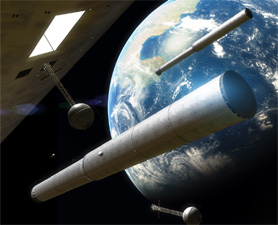
We can all hope for fast propulsion, but suppose the engineering is intractable. Would we still go to the stars if limited to speeds much less than ten percent of c? One-tenth of one percent of lightspeed gets you to Alpha Centauri in about 4300 years, which is also (very roughly) the extent of human history in terms of recoverable documents and written language. A worldship moving at this speed, in other words, recapitulates the human historical experience aboard a craft that would have to be engineered to be a living world, a vast O’Neill cylinder with propulsion.
The right kind of worldship — and Gordon Woodcock (L5 Society) worked through the engineering problems of creating such a vessel in a first-day talk — would have to be one large enough to sustain a population of thousands in conditions that were eminently livable, the complete antithesis of the cramped quarters Jan Davis experienced aboard the Shuttle. We’re all on a worldship of our own, following our star in its 230 million year journey at 220 kilometers per second around the galaxy, so perhaps a livable worldship engineered by the future Kardashev type 1 civilization we hope to grow into would be an acceptable interstellar ark.
Image: A worldship designed to hold generations of humans, as imagined by space artist Adrian Mann.
Putting the speed issue in perspective, one tenth of one percent of the speed of light is 300 kilometers per second, compared to the 17 kilometers per second that our fastest deep space probe, Voyager 1, has attained. There are ways of moving that fast that we can calculate today, but the engineering needed to produce a worldship — and the vast issues raised by creating a closed-loop ecology aboard the craft — demand a multi-disciplinary approach that takes us into biology, philosophy, sociology and the humanities as well as physics. The long-term perspective needed for such thinking was frequently discussed in Huntsville, about which more on Monday.

After Huntsville, a Red Dwarf Bonanza
Returning from Huntsville after the Tennessee Valley Interstellar Workshop, I was catching up on emails at the airport when the latest news about exoplanets and red dwarfs popped up on CNN. It was heartening to look around the Huntsville airport and see that people who had been reading or using their computers were all looking up at the screen and following the CNN story, which was no more than a thirty second summary. The interest in exoplanets is out there and may bode good things for public engagement in space matters. At least let’s hope so.
The workshop was a great success, and congratulations are owed to Les Johnson, Robert Kennedy, Eric Hughes and the entire team that made this happen (a special nod to Martha Knowles and Yohon Lo!). This morning I want to focus on the exoplanet news as a way of getting back on schedule, but tomorrow I’ll start going through my notes and talking about the Huntsville gathering. I’m hoping to have several articles in coming weeks from participants in the event on the work they are doing, and I have plenty of comments about the presentations, so the Huntsville coverage that begins tomorrow should extend into next week.
As to the exoplanet news, Courtney Dressing (Harvard-Smithsonian Center for Astrophysics) went to work on the Kepler catalog of 158,000 stars to cull out all the red dwarfs. She and the CfA’s David Charbonneau found that almost all of the identified stars were smaller and cooler than had been thought, which has the effect of lowering the size of the detected planets. An additional result is to move the habitable zone somewhat further in. The duo could find 95 planet candidates among these red dwarfs.
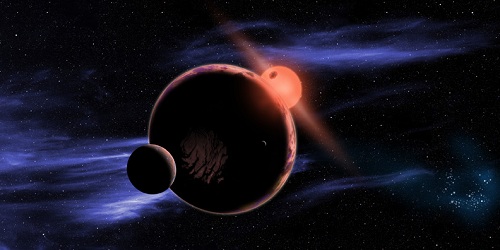
Image: This artist’s conception shows a hypothetical habitable planet with two moons orbiting a red dwarf star. Astronomers have found that 6 percent of all red dwarf stars have an Earth-sized planet in the habitable zone, which is warm enough for liquid water on the planet’s surface. Since red dwarf stars are so common, then statistically the closest Earth-like planet should be only 13 light-years away. Credit: David A. Aguilar (CfA)
Let’s pause for a moment on the analysis. Dressing and Charbonneau were comparing the observed colors of the stars to a model developed by the Dartmouth Stellar Evolutionary Program. The final sample in the study contained 3897 dwarf stars with revised temperatures cooler than 4000 K, and the revisions to stellar temperatures brought the stars down 130 K in temperature while reducing their size by 31 percent. The analysis proceeded to refit the light curves of the planet candidates to get a better understanding of their radii.
I wish I could have tracked the news conference live but was in transit at the crucial moments. Those of you who also missed it may want to check the archived version at the CFA’s site. The key point is on the opening slide: “Earth-like Planets Are Right Next Door.” Which is something of a stretch because we are talking about M-class stars where a planet in the habitable zone is probably tidally locked. Assuming (and it’s an open question) whether a benign climate for carbon-based life could exist on such a planet, it’s still an environment much different from the Earth, with a star that stays in the same position in the sky and night and day are endless.
Still, this is interesting news: The 95 planetary candidates imply statistically that at least 60 percent of red dwarfs have planets smaller than Neptune. Out of the 95, only three were close enough to Earth in terms of size and temperature to be considered ‘Earth-like.’ In other words, about six percent of all red dwarfs are found to have a planet like the Earth. 75 percent of the closest stars to the Sun are red dwarfs, leading Dressing to calculate that the closest Earth-like world is likely to be no more than 13 light years away. Again, this is for red dwarfs. The analysis of other stellar types like the intriguing G- and K-class stars Centauri A and B continues.
Here’s the payoff, from the paper. The authors have just noted that the high rate of habitable zone planets around nearby stars means that future missions designed to study these worlds will have plenty to work with::
Given that there are 248 early M dwarfs within 10 parsecs, we estimate that there are at least 3 Earth-size planets in the habitable zones of nearby M dwarfs awaiting the launch of TESS and JWST. Applying a geometric correction for the transit probability and assuming that the space density of M dwarfs is uniform, we ?nd that the nearest transiting Earth-size planet in the habitable zone of an M dwarf is less than 29 pc away with 95% con?dence. Removing the requirement that the planet transits, we ?nd that the nearest non-transiting Earthsize planet in the habitable zone is within 7 pc with 95% con?dence. The most probable distances to the nearest transiting and non-transiting Earth-size planets in the habitable zone are 18 pc and 4 pc, respectively.
I mentioned the G- and K-class stars Centauri A and B above, but I don’t want to leave the third element of the trio out, it being a red dwarf. The radial velocity work on Proxima Centauri continues, allowing us to constrain the size of possible planets usefully. This is not part of Dressing and Charbonneau’s study, but I’ll mention it here because it’s obviously germane. Using seven years of UVES spectrograph data from the European Southern Observatory, Michael Endl (University of Texas) and team have found no planet of Neptune mass or above out to 1 AU from Proxima, and no ‘super-Earths’ above 8.5 Earth masses in orbits of less than 100 days.
As to Proxima’s tight habitable zone (0.022 to 0.054 AU), no ‘super-Earths’ above about two to three Earth masses exist here. The habitable zone around Proxima corresponds to orbits ranging from 3.6 to 13.8 days, and you can see that we still have plenty of room for an interesting Earth or Mars-sized world around this closest of all stars to Earth. Adding more data points to what we already have on Proxima should gradually allow us to get to a better idea of what’s actually there.
But back to Dressing and Charbonneau’s red dwarfs. The three habitable zone candidates are Kepler Object of Interest (KOI) 1422.02 (90 percent Earth size in a 20-day orbit); KOI 2626.01 (1.4 Earth size in a 38-day orbit); and KOI 854.01 (1.7 times Earth size in a 56-day orbit). None of these are closer than 300 light years. The paper points out that while Kepler will need several more years of observation to detect Earth-size planets in the habitable zones of G-class stars (this is due to higher than expected stellar noise), the observatory is already able to detect Earth-size planets in the habitable zone of red dwarfs. We get not one but many transits per year and we have 1.8 times more likelihood of a transit than around a star like the Sun.
Thus we get this:
…the transit signal of an Earth-size planet orbiting a 3800K M star is 3.3 times deeper than the transit of an Earth-size planet across a G star because the star is 45% smaller than the Sun. The combination of a shorter orbital period, an increased transit probability, and a deeper transit depth greatly reduces the di?culty of detecting a habitable planet and has motivated numerous planet surveys to target M dwarfs…
Another advantage of M dwarfs is that confirming a planetary candidate is made easier because the radial velocity signal of a habitable planet here is considerably larger than that of a habitable zone planet around a G-class star. Given that the James Webb Space Telescope should be able to take spectra of Earth-sized planets in the habitable zone around M-dwarfs — and that it cannot do this for comparable planets around more massive stars — our first atmospheric readings from a habitable zone planet are probably going to come from these small red stars.
The paper is Dressing and Charbonneau, “The Occurrence Rate of Small Planets Around Small Stars,” to be published in The Astrophysical Journal (draft version online).

Tennessee Valley Interstellar Workshop
Air travel presents us with challenges we seldom anticipate. Flying into Charlotte on Sunday I had developed a ferocious headache. I was headed to the Tennessee Valley Interstellar Workshop in Huntsville and had a long enough layover in Charlotte to seek out a pain reliever with decongestant properties. The ridiculous thing was that I couldn’t get the plastic mini-pack open. The little symbol showed me tearing off the corner of the packet, but it wouldn’t tear for me, and it wouldn’t tear for the guy who happened to be sitting next to me at the USAir gate.
It became clear that I needed something sharp to get into this packet, but it was also clear that I was in an airport, the very definition of which these days is to prevent passengers from having anything sharp. I finally took the packet back to the kiosk I bought it from and demanded redress. The lady looked askance at me, looked at the packet, and opened it effortlessly. Further comment seems superfluous.

By the time I got off the plane in Huntsville the headache was much better, and I was surprised to find my shoulder tapped by Andreas Hein, who heads Icarus Interstellar’s worldship project, called Hyperion. We shared a taxi to the hotel, where the lobby was stuffed with interstellar folk like Rob Swinney, now project head for Project Icarus, Claudio Maccone (who will give a keynote on Tuesday), Kelvin Long (head of the Institute for Interstellar Studies) and my buddy Al Jackson, just in from Houston. Al was kind enough later to drive me over to the venue for the evening reception, pictures of which you see here. Al and I owe much to his Garmin GPS.
Image: Andreas Hein (left) and Rob Swinney, of Icarus Interstellar.

The conference — or in this case ‘workshop’ — dilemma is again facing me. There was a day when I thought ‘live blogging’ would make sense for Centauri Dreams, but the more examples of live blogging I read, the less I like the idea. At both 100 Year Starship conferences I mainly sent out tweets, finding Twitter an interesting platform for conference coverage, but one that nonetheless distracted me from making the kind of detailed notes I needed to be working with, just as live blogging did. So this time around, although I may do the occasional tweet (@centauri_dreams), I’ll mostly be paying attention to the speakers and making notes that will turn into more coverage after the workshop is over.
Image: A cordial host, MSFC’s Les Johnson, co-editor of Going Interstellar (Baen, 2012).
So bear with me if Centauri Dreams is off its regular schedule for a few days, though I’ll slip things in wherever possible, and next week we’ll take a close look at the papers here. Meanwhile, there should be no interruption in comment moderation, which I’ll get to as time allows. I will tell you this for now. Robert Kennedy (The Ultimax Group) makes a drink called the Alpha Centauri Sunrise, and I have not only had one, but have also snapped a surreptitious photo of the recipe. Robert later said it would be OK for me to share it, so at some point during the week, I’ll explain how to make this estimable drink. Hint: Three berries are involved. And moonshine.

New Book Recalls “Men Into Space”
These days we know that perhaps a million objects the size of the Tunguska impactor or larger are moving through nearby space, and talk of how to deflect asteroids has become routine. Given our increasing awareness of near-Earth objects, it wouldn’t be a surprise to hear of a new Hollywood treatment involving an Earth-threatening asteroid. But I wouldn’t have expected a science fiction series that ran from 1959 to 1960 would have depicted an asteroid mission and the dangers such objects represent.
Nonetheless, I give you “Asteroid,” from the show Men Into Space, with script by Ted Sherdeman. Viewers on November 25, 1959 saw the show’s protagonist Col. Edward McCauley (William Lundigan) take a crew to ‘Skyra,’ a 3.5-kilometer long rock that scientists believed might hit the Earth. The crew assesses whether the asteroid is salvageable for use as a space station and decides there is no other choice but to destroy Skyra, which they do at the cost of considerable suspense as McCauley works to save an astronaut separated from the others while the clock ticks down. The suspense would have been heightened by the fact that this was a show on which astronauts sometimes died and hard sacrifices were the order of the day.
I report on all this with the help of John Fredriksen’s new book Men Into Space (BearManor Media, 2013), which arrived in the mail the other day. Like me, Fredriksen had watched the show in its all too short run while growing up in the Sputnik era. He was taken with the understated but tough role of McCauley, who was depicted as participating in all the significant space missions of his time, from the first lunar journeys to building a space station and, at the time of the show’s cancellation, two attempted flights to Mars that were plagued by problems and aborted.
You could say that Mars as a destination hovers over all this show’s plots. Its final episode, “Flight to the Red Planet,” did get McCauley and team as far as Phobos, where their ship was damaged enough to force an early departure without landing on Mars itself. The Mars of this episode is a compelling target, because from Phobos, in these years not long before Mariner 4, the crew can see waterways that seem to be feeding an irrigation system. This is Percival Lowell’s Mars in an episode surely designed to build into a second season, but that season was unfortunately not to be.
Fredriksen’s book walks fans through all the episodes, with extensive quotes from the scripts and stills that capture the look and feel of the production. If some of these images seem familiar, it may be because Chesley Bonestell was asked to produce concept art for the show, resulting in sharply defined lunar landscapes reminiscent of his paintings. Lewis Rachmil, who produced Men Into Space, would have been familiar with Bonestell’s Hollywood work, which included Destination Moon (1950), When Worlds Collide (1951) and Conquest of Space (1955), not to mention the famous space series in Collier’s.
Frederic Ziv, who headed up ZIV Productions, didn’t stop with Bonestell when it came to making his show as realistic as the times would allow. Sputnik had been launched in 1957 and Ziv had been exploring doing a different kind of space show for CBS ever since. From the book:
Unlike the children-oriented science fiction programming of a few years previous, the tenor of the times now demanded an approach that was rigorously scientific to appease more mature audiences. Ziv, who prized flaunting the technical expertise assisting his programs, also believed that obtaining Department of Defense cooperation facilitated access to their extensive and elaborate space facilities. At length, his show acknowledged help from the Air Force Air Research and Development Command, the Office of the Surgeon General, and the School of Aviation Medicine. Ziv’s credibility was further enhanced with Air Force technical experts who were brought into the scripting and consulting process, receiving credits in the end titles.
Couple this with location shooting at research facilities like Edwards Air Force Base and Cape Canaveral and stock footage of missile launches of the time, along with special effects crews working with von Braun-style three-stage rockets launching capsules that were almost as tiny and cramped as Apollo. Men Into Space turned out to be complicated and expensive. Fredriksen notes that ZIV gave the Air Force the final say in keeping the show realistic, which is why the more fantastic tropes of 1950s science fiction make no appearance. Personality conflicts and equipment malfunctions took the place of ray guns and aliens.

Fredriksen gives all the details, including a summary of each of the show’s 38 episodes. It’s a nostalgic trip for those who remember watching Men Into Space, and it brings back to life memories many of us had long forgotten. After all, this was a short-lived series that survived only in occasional syndication and in some of the space suits and ship interiors that wound up being used again in episodes of The Outer Limits (I knew they looked familiar!). Nominated for a Hugo Award in 1960, the show lost out to The Twilight Zone, and critics sniped at its mundane special effects and earnest quest for authenticity. Despite the promise of Mars, the show was axed in September of that year.
But early impressions count, and it’s safe to say that this show captured more than a few young minds, not the least of them being Fredriksen’s, for whom the experience was indelible:
May future generations rekindle that sense of awe, the ability to dream a better future, and a fixed determination to cross the gulf separating imagination from reality as we did, and joyously so, in the 1950s. If Men Into Space encapsulates the essence of a departed, heroic ideal, it is also a good measure of everything we have lost as a space-faring culture.
As for me, I’ve always been a William Lundigan fan. This is a guy who walked away from Hollywood in 1943 to join the Marines, where he served with the 1st Marine Division on Peleliu, an operation that ranks with Iwo Jima in terms of the ferocity of combat and the staggering percentage of casualties. He went on to Okinawa as a combat photographer and, having received two Bronze Stars, returned to acting after the war. 1954’s Riders to the Stars was his first science fictional outing in a show about astronauts trying to capture meteorites in flight. His work with Ivan Tors on that film fed into a role in the series debut of ZIV’s Science Fiction Theater.
Of Men Into Space, Lundigan would say: “…this was not some Buck Rogers type show. It was not a science-fiction series but a science-fact series. You might even say it’s a combination of a public service show and a dramatic series.” Even he would become exasperated with the quality of writing in some of the later shows, but as Fredriksen’s book makes clear, there was still inspiration to be found here of the kind that awakens young people to careers in engineering and science. With a little better luck and a second season landing on Mars, Men Into Space might be far more than the obscure recollection it is today, and the name ‘McCauley’ might be as recognizable as ‘Kirk.’

Habitable Zones: A Moving Target
Habitable zones are always easy enough to explain when you invoke the ‘Goldilocks’ principle, but every time I talk about these matters there’s always someone who wants to know how we can speak about places being ‘not too hot, not too cold, but just right.’ After all, we’re a sample of one, and why shouldn’t there be living creatures beneath icy ocean crusts or on worlds hotter than we could tolerate? I always point out that we have to work with what we know, that water and carbon-based life are what we’re likely to be able to detect, and that we need to fund the missions to find it.
The last word on habitable zone models has for years been Kasting, Whitmire and Reynolds on “Habitable Zones around Main Sequence Stars.” Now Ravi Kopparapu (Penn State) has worked with Kasting and a team of researchers to tune-up the older model, giving us new boundaries based on more recent insights into how water and carbon dioxide absorb light. Both models work with well defined boundaries, the inner edge of the habitable zone being determined by a ‘moist greenhouse effect,’ where the stratosphere becomes saturated by water and hydrogen begins to escape into space.
The outer boundary is defined by the ‘maximum greenhouse limit,’ where the greenhouse effect fails as CO2 begins to condense out of the atmosphere and the surface becomes too cold for liquid water. When worked out for our own Solar System in terms of astronomical units, the 1993 model showed the habitable zone parameters extending from 0.95 to 1.67 AU. Earth was thus near the inner edge.
The new model improves the climate model and works out revised estimates for the habitable zones around not just Sun-like G-class stars but F, K and M stars as well. The definition uses atmospheric databases called HITRAN (high-resolution transmission molecular absorption) and HITEMP (high-temperature spectroscopic absorption parameters) that characterize planetary atmospheres in light of how both carbon dioxide and water are absorbed. The revision of these databases allows the authors to move the HZ boundaries further out from their stars than they were before.
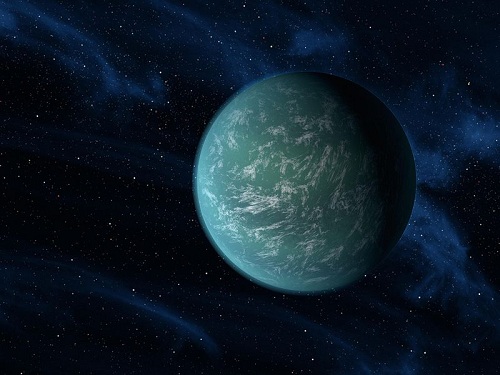
Image: An artist’s conception of Kepler-22b, once thought to be positioned in its star’s habitable zone. New work on habitable zones suggests the planet is actually too hot to be habitable. Credit: NASA/Ames/JPL-Caltech.
This looks to be an important revision, one that people like Rory Barnes (University of Washington) are already calling ‘the new gold standard for the habitable zone’ (see Earth and others lose status as Goldilocks worlds) in New Scientist. In Solar System terms, the limits now become 0.99 AU and 1.70 AU. We see that the Earth moves closer to the inner edge of the habitable zone, causing the authors to comment about an important part of their analysis, that it does not factor in the effect of clouds:
…this apparent instability is deceptive, because the calculations do not take into account the likely increase in Earth’s albedo that would be caused by water clouds on a warmer Earth. Furthermore, these calculations assume a fully saturated troposphere that maximizes the greenhouse e?ect. For both reasons, it is likely that the actual HZ inner edge is closer to the Sun than our moist greenhouse limit indicates. Note that the moist greenhouse in our model occurs at a surface temperature of 340 K. The current average surface temperature of the Earth is only 288 K. Even a modest (5-10 degree) increase in the current surface temperature could have devastating a?ects on the habitability of Earth from a human standpoint. Consequently, though we identify the moist greenhouse limit as the inner edge of the habitable zone, habitable conditions for humans could disappear well before Earth reaches this limit.
While the small change to the Earth’s position in the habitable zone is getting most of the press attention, I’m more interested in what the new numbers say about M-dwarfs. These small red stars would have habitable zones close enough to the star that the likelihood of a transit increases. The 1993 habitable zone work did not model M-dwarfs with effective temperatures lower than 3700 K whereas the new work takes effective temperatures down to 2600 K. In an article run by NBC News, Abel Mendez (University of Puerto Rico at Arecibo) mentions that Gliese 581d, thought to skirt the outer limits of its star’s habitable zone, may now move toward the habitable zone’s center, increasing the possibility of life emerging there. Other planets catalogued by the Planetary Habitability Laboratory at UPR will be affected as some thought to have been in the habitable zone may move out of it. See A New Habitable Zone for more.
There are other factors to consider about M-dwarfs, especially the fact that planets close enough to these stars to be in the habitable zone are most likely tidally locked, presenting the same face to the star at all times. Neither the 1993 model or this revised one does well at representing a tidally locked world and the authors say they have not tried to explore synchronously rotating planets in different parts of the habitable zone around M-dwarfs. The paper does note that a planet near the outer edge of the HZ with a dense CO2 atmosphere should be more effective at moving heat to the night side, perhaps increasing the chances of habitability.
The overall effect of adjusting our parameters for habitable zones around the various stellar classes will be to improve our accuracy as we look toward producing lists of targets for future space-based observatories. The authors note that the James Webb Space Telescope, for example, is thought to be marginally capable of taking a transit spectrum of an Earth-like planet orbiting an M-dwarf. We’ll need the maximum chance for success before committing resources to specific planets once we get into the business of trying to identify biomarkers on possibly habitable worlds.
The paper is Kopparapu et al., “Habitable Zones Around Main-Sequence Stars: New Estimates,” accepted at the The Astrophysical Journal (preprint). Note that a habitable zone calculator based on this work is available online. The 1993 paper is Kasting, Whitmire and Reynolds, “Habitable Zones around Main Sequence Stars,” Icarus 101 (1993), pp. 108-128 (full text).

